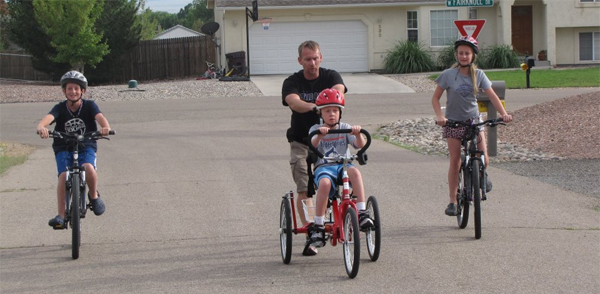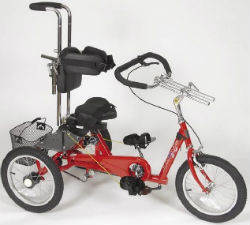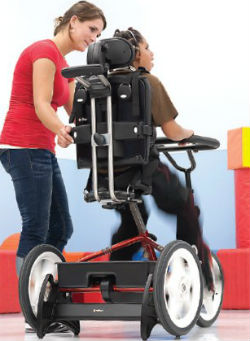
Resources
An option that is standard on some bicycles and an additional accessory on others. Rear steer (which may also referred to as caregiver assist or guide bar) is a feature that allows the caregiver to control navigation and assist with pedaling as a child is learning.
The Top 10 Tips For Purchasing An Adaptive Bike
We all remember our first bike, in fact, it's one of the best parts about being a kid! Bikes give kids their own sense of freedom, pride and self assurance they just don't get in the same way in other areas. In addition to the fun, it's great socialization with friends, family and peers. It goes without saying that kids with special needs are no different. In fact, an adaptive bike may even be more important as so many avenues available to other kids to socialize and exercise aren't as available for a children with limited mobility. Adaptive bicycles are a wonderful addition for an active outdoors family, because it truly allows for everyone to be included! We're hoping to shed a little more light onto the subject of adaptive bicycles and how to choose one, we've found it can be quite daunting to parents. The term, Adaptive Bicycle and Tricycle are used interchangeably since all adaptive bicycles have a 3 wheel frame to increase the base of support. Here are some of the important features on adaptive bicycles that can help you navigate some of the options. 1. Rear Steer/Front Guidebar
1. Rear Steer/Front Guidebar
An option that is standard on some bicycles and an additional accessory on others. Rear steer (which may also referred to as caregiver assist or guide bar) is a feature that allows the caregiver to control navigation and assist with pedaling as a child is learning.
2. Head Support
Head support provides the head necessary support to promote an upright head position. Head support can be crucial for a little rider with low to moderate balance. The top adaptive bikes all offer either removable or adjustable headrests to provide greater head and neck support allowing greater balance and focus while riding.3. Handlebar Options
Wide (more standard 'U' Shape) or Loop are commonly available. We generally recommend Loop Style for most riders as it makes hand positioning easier for a wide variety of riders to have control.4. Chest Support/Laterals
Laterals are an optional accessory to increase trunk support and promote upright positioning. Chest supports are also available to assist with upright trunk positioning.5. Shifting, Power Assist and Reciprocation/Engagement
For users with limited mobility, automatic gear shifting can make a big difference. Power Assist can help on hills or with tired little legs. Reciprocators move the pedals for children who are unable to consistently pedal the bike themselves. This feature allows the child to assist when possible and still receive the benefits of range of motion that cycling provides.6. Hand vs Foot Cycling
Depending on the needs of the child this is a crucial decision. For children with very limited lower mobility, a Hand Cycle powered bike is the obvious choice and a great way to improve balance and upper body strength!7. Indoor Use/Stationary Stand
Some bikes have options for indoor use. Rifton for example offers the Stationary Stand. This is wonderful in a clinical setting or at home to build strength, balance, or when the weather is less than optimal!8. Color
This is VERY important... think of it like a car for your child. Red, Blue, Purple, Green, Metallic? Let them choose! Some of the manufacturers even take the customization a step further and let you choose stickers or even an animal squeaky toy!9. Postural Support
Postural support is offered along a continuum with the adaptive bicycles falling on the range between least to most. The Kaye ToniCross or the AmTryke are at the lower end of support with the Freedom Concepts bicycles offering the most support. Some manufacturers have gone a step further by listing specific diagnoses that are recommended to use the bicycle. *This is meant as a guide and not as a one size fits all according to the diagnosis.10. Measurement:
Finally, it is important to properly measure a child in order to select the most appropriate size of bicycle. Each manufacturer lists the measurements that are required to be able to determine the size needed. Please pay close attention to this. Tadpole Adaptive also has a link that demonstrates the proper way to measure. Please reference this as needed.An adaptive bike for wheelchair users
Can a child who uses a wheelchair use an adaptive bike? You Bet! When selecting an adaptive bike and components for children who use wheelchairs, it is best to consider the amount of support a child needs to sit. Here are just a few questions to consider and can be a good starting point for a discussion with your child's therapist:- Is the child able to sit independently or is support required?
- Can the child hold their head up against gravity independently for long periods of time, or do they fatigue easily and look down?
- To they have high tone that requires positioning devices to keep them seated?



